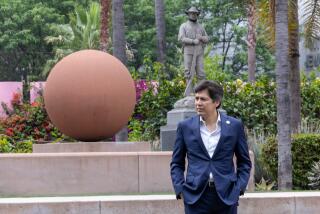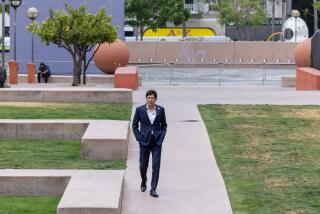To Mayor, It’s Selma’s Statue of Limitations
- Share via
SELMA, Ala. — Not even a week into his term as Selma’s first black mayor, James Perkins Jr. had to stand face to face with a cast-iron reminder of his town’s openly racist ways.
There, under one of the arching, graying oak trees that line the streets and make Selma feel as old as it is, glared Nathan Bedford Forrest, a Confederate general who died 123 years ago.
No matter that the great cavalry man had been reduced to a hollow bust and block of granite. His defiant scowl, like many relics of the past here, was inescapable.
Many of Selma’s black residents were furious. Forrest wasn’t simply a Confederate general; he was the first grand wizard of the Ku Klux Klan.
Worse, the group that unveiled the statue decorated it with a Confederate battle flag and somehow won the right to stick the statue in a black neighborhood on a piece of city-owned property.
“What good judgment to do this my first week in office,” Perkins said wryly. “If I remove the statue, whites will be upset. If I don’t, blacks will be angry.”
Swept into office last month by an energy untapped since the civil rights days, Perkins is learning how easy it is to get squeezed between the narrowing jaws of the racial vise. Part of the problem is Selma’s stubborn sense of history. The town, full of antebellum mansions and old stores and old stories, has a motto painted on billboards and printed in tourist books: “History Lives in Selma.” Some of that history, though, clearly is offensive.
But the 47-year-old mayor, a computer consultant who has never held office before, is intent on doing what few other politicians, white or black, North or South, are inclined to do. He wants to confront his community’s past. He wants to wipe out de facto segregation in the city’s polarized schools. He wants to chip away at generations of distrust. His boldest idea is forming a truth and reconciliation commission, akin to South Africa’s, to set the record straight about Selma’s troubled history.
“If it worked for them, it could work for us,” he said.
White Mayor’s 36-Year Run Broken
These goals helped carry Perkins last month to an election victory that became historic in itself. Not since the Rev. Martin Luther King Jr. led thousands of people in 1965 from Selma to Montgomery in a march for the unimpeded right to vote have the streets of majority-black Selma erupted with such euphoria.
The town held a coronation--a three-day affair of picnics and parties and speeches from balconies, church services and motorcades and a parade down Broad Street with thundering bass drums and little boys with sweat-slicked faces singing songs praising God. “Way to go, Perk!” people yelled as the new mayor passed by.
While blacks have heralded Perkins as their savior--”the man took the shackles off us,” said Charles Dickson, a Selma machine operator--many white residents are anxious. From the working-class whites who sand down furniture in antique shops along the Alabama River to those up the road nibbling on lemon-pepper chicken at the all-white Selma Country Club, Perkins’ victory is an unsettling break with the past. For the last 36 years, Selma, which is 65% black, had a white mayor--the same white mayor--a former refrigerator salesman and onetime segregationist named Joe Smitherman.
“Who knows what’s going to happen to this city now,” said Robert Gordon, a white antiques dealer.
It may not be the law, but segregation is still the rule in Selma. Here, there are two sets of everything. There are the all-black bars and the all-white bars, the black grocery stores and the white ones, the public high school that is 98.7% black and the two private academies in town that are pure white. There’s the black Baptist church and the white Baptist church, the black cemetery and, across town, the white one.
There are similar stories in many small Southern cities. But Selma, population 24,000, has the added burden of being a place where people paid a heavy price for racial equality. Before King successfully led marchers to Montgomery, state troopers gassed and beat scores of civil rights demonstrators as they walked across a bridge to leave Selma. That day, March 7, 1965, is now remembered as Bloody Sunday, a pivotal moment in the civil rights movement. The saddest thing about looking back, Perkins said, is that so little has changed.
“When I returned from Birmingham in 1991,” Perkins said, “I couldn’t stand Selma for what it was. Nothing had happened since civil rights. If we weren’t going to be anything but a segregated school system and a segregated town, why had we sacrificed so much?”
Called On From Above
Perkins was born and raised in this Cotton Belt town and joined the movement as it unfolded in front of him. He marched in the streets and sat in at lunch counters as a young boy, although his folks kept him from the bridge that day when so many blacks were hurt. He grew up middle class, his father an elementary school principal, his mother a nurse. He was in the first integrated class at Selma High School and petitioned, unsuccessfully, to have white kids move to the black high school instead of the other way around.
“He was a serious, serious student,” said Mira Dawson, Selma’s sole Avon lady who went to school with the mayor.
Perkins studied computer science and math at Alabama A & M, the state’s black university, and then left the Deep South to install computer systems for companies in Illinois, Florida and Washington, D.C. He returned to Selma in 1980 to oversee the mayoral campaign of the Rev. F. D. Reese, the first black man to make a serious run at Smitherman. Reese lost, Perkins left again and he didn’t come back until 1991, when he said God called upon him to run for mayor.
Religion steers the life and ambitions of James Perkins Jr. He’s a Sunday school teacher, solidly grounded in Baptist morals and a fatalism that says whatever happens, happens for a reason. He’s cast from the signature mold of Selma--a deeply religious place where it’s difficult to have a conversation without God coming up and where you see people reading lovingly thumbed Bibles behind hotel desks and on park benches.
“Mr. Perkins, he’s a God-sent man,” fisherman Willie Taylor said.
In his first campaign in 1992, Perkins lost to Smitherman by 600 votes. Four years later it was 300 votes. The political terra firma was turning to quicksand under Smitherman’s feet. By this point, the Selma City Council and the commission of surrounding Dallas County were ruled by majority black boards. African Americans had eclipsed whites on the voting rolls. All of this factored into the calculus that swept Perkins to a 58%-42% victory Sept. 12.
“Most Selma elections follow racial lines,” said Alston Fitts, an Edmundite missionary and one of the city’s armchair historians. “The key to this election was we had to convince [all voters] that it wouldn’t be the end of the world if Selma had a black mayor.”
Perkins was aided by African American activists who launched a street-level “Joe Gotta Go” campaign that helped drive black voter turnout.
That campaign, along with all the attention Perkins was getting from around the country, proved too much for even a wily politician like Smitherman.
“I wasn’t just running against Perkins,” said Smitherman, 70. “I was running against ‘Joe Gotta Go,’ the [National Assn. for the Advancement of Colored People] and the national media.”
The election wasn’t strictly a black-white contest. A handful of whites, like Fitts, voted for Perkins, and a small number of blacks cast ballots for Smitherman.
The ugly rift concerning the Confederate statue may not be purely black vs. white either. But it has driven a wedge between the two communities at a time when tensions are running higher than they have in a long time.
The $25,000 statue was placed behind a city-run museum that was a Confederate hospital during the Civil War. The mayor didn’t even know about the unveiling. Members of the Sons of Confederate Veterans showed up in battle grays and gave speeches celebrating the Old South.
“It was like a Klan meeting without the hoods,” said Walter Curtis, a black Selma police officer who was there.
Benny Austin, a statue supporter who traces his ancestry to men who fought in the Civil War, said the statue celebrated Forrest’s valor in trying to defend Selma, not his Klan work. Forrest helped found the Klan in 1867 but quit two years later. The mayor wasn’t invited to the unveiling, which had been planned for months, Austin said, because there were fears it could become “a little controversial.”
Perkins is a hard man to make angry. But he’s angry now. He takes the whole statue issue--the timing, the way he was blindsided, the idea that a group of people in this era would put a Klan founder literally on a pedestal--as a personal affront. True, Perkins said, a city board under the previous mayor did approve the project, although apparently without much research. But that was a different day.
“I’ll be fair, but I’ll be firm,” said Perkins, who has told the Sons of Confederate Veterans that the statue must be moved to an alternative location. It’s not clear whether the mayor has the authority to order the monument be removed.
The statue supporters say they have no plans to move the 10,000-pound chunk of a monument.
Regardless of how Perkins fares in this first challenge, some of the old-timers say this is what he faces in a town where the past courses through the veins of people like the source of life itself.
“You lose control of your city government and a week later you put up a statue to a Confederate general?” said Ross Hobbs, a white school administrator. “How Southern. These heritage guys are basically saying what a lot of people around here feel: The fight goes on. The war never really ends.”
More to Read
Get the L.A. Times Politics newsletter
Deeply reported insights into legislation, politics and policy from Sacramento, Washington and beyond. In your inbox three times per week.
You may occasionally receive promotional content from the Los Angeles Times.










